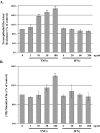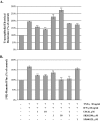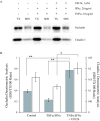Proinflammatory cytokines tumor necrosis factor-alpha and interferon-gamma modulate epithelial barrier function in Madin-Darby canine kidney cells through mitogen activated protein kinase signaling
- PMID: 16504032
- PMCID: PMC1402323
- DOI: 10.1186/1472-6793-6-2
Proinflammatory cytokines tumor necrosis factor-alpha and interferon-gamma modulate epithelial barrier function in Madin-Darby canine kidney cells through mitogen activated protein kinase signaling
Abstract
Background: The tight junction is a dynamic structure that is regulated by a number of cellular signaling processes. Occludin, claudin-1, claudin-2 and claudin-3 are integral membrane proteins found in the tight junction of MDCK cells. These proteins are restricted to this region of the membrane by a complex array of intracellular proteins which are tethered to the cytoskeleton. Alteration of these tight junction protein complexes during pathological events leads to impaired epithelial barrier function that perturbs water and electrolyte homeostasis. We examined MDCK cell barrier function in response to challenge by the proinflammatory cytokines tumor necrosis factor-alpha (TNFalpha) and interferon-gamma (IFNgamma).
Results: Exposure of MDCK cells to TNFalpha/IFNgamma resulted in a marked sustained elevation of transepithelial electrical resistance (TER) as well as elevated paracellular permeability. We demonstrate that the combination of TNFalpha/IFNgamma at doses used in this study do not significantly induce MDCK cell apoptosis. We observed significant alterations in occludin, claudin-1 and claudin-2 protein expression, junctional localization and substantial cytoskeletal reorganization. Pharmacological inhibition of ERK1/2 and p38 signaling blocked the deleterious effects of the proinflammatory cytokines on barrier function.
Conclusion: These data strongly suggest that downstream effectors of MAP kinase signaling pathways mediate the TNFalpha/IFNgamma-induced junctional reorganization that modulates MDCK cell barrier function.
Figures



 ), TNFα/IFNγ, 3/6 ng/ml (
), TNFα/IFNγ, 3/6 ng/ml ( ), TNFα/IFNγ, 10/20 ng/ml (
), TNFα/IFNγ, 10/20 ng/ml ( ), and TNFα/IFNγ, 30/60 ng/ml (
), and TNFα/IFNγ, 30/60 ng/ml ( ). Panel B reports the mean [3H]-mannitol flux following 72 hour incubation with the indicated treatments. Flux is presented as the percent of apical [3H]-mannitol recovered in the basolateral chamber following 120 min. incubation. Error bars represent the SE, n = 6. A one-way analysis of variance (ANOVA) was performed, multiple comparisons between control and treatments were determined with the Bonferroni post test. **Indicates statistical difference (P < 0.001) to control.
). Panel B reports the mean [3H]-mannitol flux following 72 hour incubation with the indicated treatments. Flux is presented as the percent of apical [3H]-mannitol recovered in the basolateral chamber following 120 min. incubation. Error bars represent the SE, n = 6. A one-way analysis of variance (ANOVA) was performed, multiple comparisons between control and treatments were determined with the Bonferroni post test. **Indicates statistical difference (P < 0.001) to control.



Similar articles
-
Remodeling of the tight junction during recovery from exposure to hydrogen peroxide in kidney epithelial cells.Free Radic Biol Med. 2009 Dec 1;47(11):1561-9. doi: 10.1016/j.freeradbiomed.2009.08.024. Epub 2009 Sep 3. Free Radic Biol Med. 2009. PMID: 19733232 Free PMC article.
-
Protamine-induced epithelial barrier disruption involves rearrangement of cytoskeleton and decreased tight junction-associated protein expression in cultured MDCK strains.Cell Struct Funct. 2005 Feb;29(5-6):165-78. doi: 10.1247/csf.29.165. Cell Struct Funct. 2005. PMID: 15840948
-
Restoration of tight junction structure and barrier function by down-regulation of the mitogen-activated protein kinase pathway in ras-transformed Madin-Darby canine kidney cells.Mol Biol Cell. 2000 Mar;11(3):849-62. doi: 10.1091/mbc.11.3.849. Mol Biol Cell. 2000. PMID: 10712504 Free PMC article.
-
Tight junctions and cell-cell interactions.Methods Mol Biol. 2006;341:185-95. doi: 10.1385/1-59745-113-4:185. Methods Mol Biol. 2006. PMID: 16799199 Review.
-
Cytokine regulation of tight junctions.Biochim Biophys Acta. 2009 Apr;1788(4):864-71. doi: 10.1016/j.bbamem.2008.08.027. Epub 2008 Oct 8. Biochim Biophys Acta. 2009. PMID: 18952050 Free PMC article. Review.
Cited by
-
Epithelial permeability alterations in an in vitro air-liquid interface model of allergic fungal rhinosinusitis.Int Forum Allergy Rhinol. 2013 Jan;3(1):19-25. doi: 10.1002/alr.21077. Epub 2012 Aug 27. Int Forum Allergy Rhinol. 2013. PMID: 22927233 Free PMC article.
-
Remodeling of the tight junction during recovery from exposure to hydrogen peroxide in kidney epithelial cells.Free Radic Biol Med. 2009 Dec 1;47(11):1561-9. doi: 10.1016/j.freeradbiomed.2009.08.024. Epub 2009 Sep 3. Free Radic Biol Med. 2009. PMID: 19733232 Free PMC article.
-
Regulation of paracellular permeability: factors and mechanisms.Mol Biol Rep. 2013 Nov;40(11):6123-42. doi: 10.1007/s11033-013-2724-y. Epub 2013 Sep 24. Mol Biol Rep. 2013. PMID: 24062072 Review.
-
Assessment of the relationship between gut microbiota and bone mineral density: a two-sample Mendelian randomization study.Front Microbiol. 2024 May 22;15:1298838. doi: 10.3389/fmicb.2024.1298838. eCollection 2024. Front Microbiol. 2024. PMID: 38841058 Free PMC article.
-
Enterococcus faecalis Gelatinase Mediates Intestinal Permeability via Protease-Activated Receptor 2.Infect Immun. 2015 Jul;83(7):2762-70. doi: 10.1128/IAI.00425-15. Epub 2015 Apr 27. Infect Immun. 2015. PMID: 25916983 Free PMC article.
References
-
- Anderson JM, Van Itallie CM. Tight junctions and the molecular basis for regulation of paracellular permeability. Am J Physiol. 1995;269:G467–75. - PubMed
-
- Martin-Padura I, Lostaglio S, Schneemann M, Williams L, Romano M, Fruscella P, Panzeri C, Stoppacciaro A, Ruco L, Villa A, Simmons D, Dejana E. Junctional adhesion molecule, a novel member of the immunoglobulin superfamily that distributes at intercellular junctions and modulates monocyte transmigration. J Cell Biol. 1998;142:117–127. doi: 10.1083/jcb.142.1.117. - DOI - PMC - PubMed
-
- Mitic LL, Van Itallie CM, Anderson JM. Molecular physiology and pathophysiology of tight junctions I. Tight junction structure and function: lessons from mutant animals and proteins. Am J Physiol Gastrointest Liver Physiol. 2000;279:G250–4. - PubMed
Publication types
MeSH terms
Substances
Grants and funding
LinkOut - more resources
Full Text Sources
Miscellaneous

